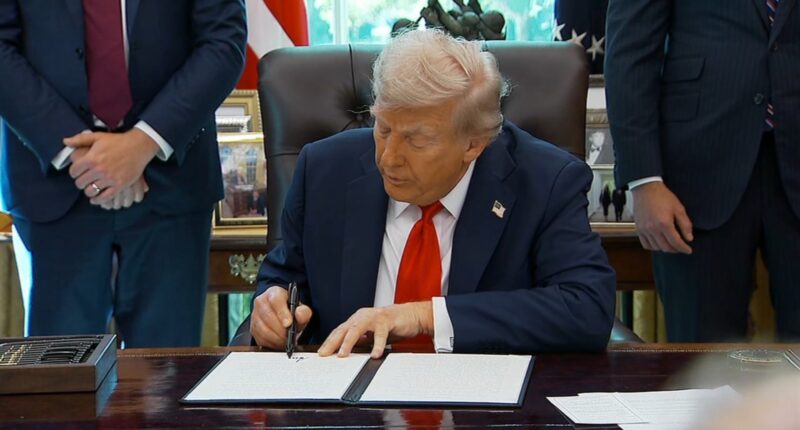Share this @internewscast.com
On Monday, President Donald Trump issued an executive order threatening to cut or withdraw federal funding from local and state governments that implement cashless bail, claiming it endangers public safety.
“No cash. Come back in a couple of months, we’ll give you a trial. You never see the person again,” he said, moments before signing the order.
According to the order, Attorney General Pam Bondi is required to provide a list of jurisdictions that have “significantly removed cash bail as a possible condition of pretrial release for crimes that clearly threaten public safety and order” within 30 days.
Advocates of removing cash bail argue that it unfairly penalizes the poor, allowing the wealthy to secure their release and await trial while those with limited finances remain incarcerated. Opponents of cashless systems contend that bail is a traditional method to ensure released defendants appear for court hearings, cautioning that releasing violent offenders before trial may enable further criminal activities.
Here’s what to know:
What it is
Cashless bail involves policies releasing individuals from jail without requiring payment as they await trial. This approach contrasts with the traditional cash bail system, where money is paid for release and reimbursed if court appearances are fulfilled. The Eighth Amendment of the Constitution forbids excessive bail.
Where it’s offered
In 2023, Illinois made history as the first state to discard cash bail, following the state Supreme Court’s validation of a law eliminating it. This reform was part of a comprehensive criminal justice update called the SAFE-T Act, implemented in 2021. The law empowers judges to decide whether to release defendants before trial by assessing their criminal charges, potential danger to others, and flight risk status.
Several other areas, such as New Jersey, New Mexico, and Washington, D.C., have largely abolished cash bail or restricted its application. They have adopted measures like reminders for court dates, transport vouchers, flexible scheduling, and on-site childcare to improve court attendance among those released without bail.
When it’s offered
Policies vary by jurisdiction, but many exclude the use of cashless bail for more serious crimes such as murder and other violent offenses. Cashless bail might also be denied if there is concern an individual might flee before trial. In some cases, it is granted automatically for misdemeanors and nonviolent felonies.
The impact on crime
Studies have shown mixed results regarding the impact of cashless bail on crime. Many focus on the recidivism of individual defendants rather than overall crime rates.
Loyola University of Chicago’s Center for Criminal Justice published a 2024 report on Illinois’ new cashless bail policy, one year after it went into effect. It acknowledges that there is not yet enough data to know what impact the law has had on crime, but that crime in Illinois did not increase after its implementation. Violent and property crime declined in some counties.
A 2024 report published by the Brennan Center for Justice saw “no statistically significant relationship” between bail reform and crime rates. It looked at crime rate data from 2015 through 2021 for 33 cities across the U.S., 22 of which had instituted some type of bail reform. Researchers used a statistical method to determine if crime rates had diverged in those with reforms and those without. The report found that “put simply” there was no “significant difference in crime rates between cities that reformed their bail policies and those that did not.”
Asked last month what data Trump was using to support his claim that cashless bail leads to increase in crime, the White House pointed to a 2022 report from the district attorney’s office in Yolo County, California, that looked at how a temporary cashless bail system implemented across the state to prevent COVID-19 outbreaks in courts and jails impacted recidivism. It found that out of 595 individuals released between April 2020 and May 2021 under this system, 70.6% were arrested again after they were released. A little more than half were rearrested more than once.
Copyright © 2025 by The Associated Press. All Rights Reserved.
















